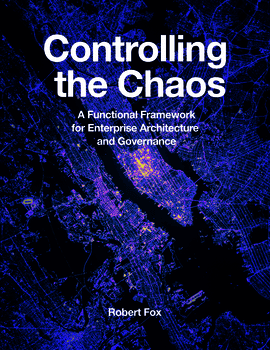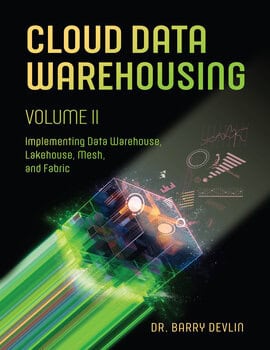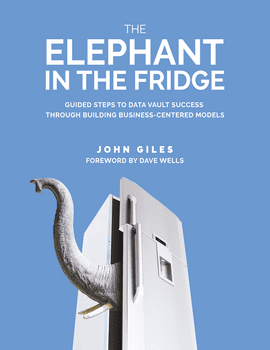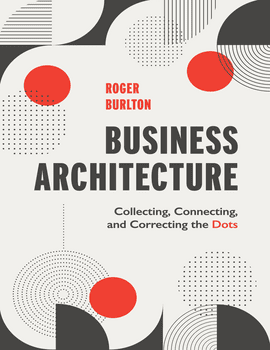Controlling the Chaos
Controlling the Chaos: A Functional Framework for Enterprise Architecture and Governance, by Robert Fox
Topics
CHAPTER 1: EAG History
1987 – The Zachman Framework (John Zachman)
1989 – National Institute of Technology (NIST) Model
1992 – Stephen Spewak – Enterprise Architecture Planning (EAP)
1994 – The Open Group Architectural Framework (TOGAF)
1996 – Control Objectives for Information Technology (COBIT)
1989-1996 – Information Technology Infrastructure Library (ITIL)
CHAPTER 2: EAG Functional Framework
Why architecture and governance programs fail
Using TOGAF, ITIL, and more
What is a “function”?
Organizing your functions
Managing functions – adding architecture and governance
CHAPTER 3: The Business Domain
Business Architecture in an EAG program
Business functions
CHAPTER 4: The Information Domain
Information architecture in an EA program
Information as a competitive differentiator
Two kinds of people – knowledge sharers versus knowledge hoarders
Trends
Information lifecycle functions
Information services functions
CHAPTER 5: The Application Domain
Two kinds of people – structured learners versus researchers
Software infrastructure lifecycle functions
Two kinds of people – motivated versus unmotivated
Software development lifecycle functions
Trend: Disappearance of the network edge
Two kinds of people – conflict embracers versus conflict avoiders
Software services functions
CHAPTER 6: The Technology Domain
Two kinds of people – deep focus versus broad focus
Hardware lifecycle functions
Trend: The virtualization of hardware
Conclusion: One Kind of People
Appendix Forms and Templates
Using this framework, the mind-numbing array of functionality that IT manages on behalf of the business is organized into a few simple, intuitive lifecycles. The framework then paints a clear, compelling picture of how to organize both your enterprise architecture and your IT governance efforts for all of these IT functions into a consistent, comprehensive program that is easy to understand and manage.
This framework treats architecture and governance as two sides of the same coin: managing your future vision and the roadmap to get there (architecture) and managing your day-to-day operations using policies, standards, processes and roles (governance). This novel approach combines the holistic view of IT functions with the structures to manage each function’s architecture and governance in a holistic program.
After describing the functional framework concept, the text brings life to the structure, drawing practical insights from the author’s 30 years of architecture and governance experience across several industries. The examples illustrate the difference between managing IT functions in isolation and managing them as part of an integrated enterprise solution, frankly admitting where and why architecture and governance programs are failing to provide their promised value. The book admits that the root causes of these failures are sometimes found in poor processes, but are just as often the result of poor staffing and office politics, all of which must be addressed to be successful.
From a governance standpoint, the framework paints a picture of IT governance which brings a clarity and vision that has been sadly lacking in most industry discussions. It is an imminently practical approach to building a governance program that allows any IT organization to manage their infrastructure simply and consistently using a mature, time-tested approach. Using this framework will elevate your governance from vaguely defined departmental efforts to a coordinated, easily understood, easily managed enterprise-level program that simplifies the management of IT infrastructure while keeping it focused on supporting the business and returning value.
From an architectural standpoint, the framework squarely faces challenges such as complying with emerging security standards, the increasing role of data analytics, and the virtualization of hardware and software into the cloud – discussing how and when to begin preparing for the disruptive technology of the near future. And the book addresses the frequent failure of enterprise architecture programs to provide business value, discussing the simple changes that must be made to transform these money-pits into valuable business partners.
This is not a training manual for managing individual IT functions. Rather, it is a vision for how to manage all of these functions as parts of a single, integrated, comprehensive enterprise architecture and governance program that is focused on providing value to the business. This book is intended for both IT and business professionals, from executives to front-line technicians, who are trying to control their IT infrastructure.
About Robert
In the years since his graduation from Duke University in 1986, Robert Fox has been involved with architecture and governance in the banking, retail sales, telecom and insurance industries, holding positions from developer to manager, and from enterprise architect to the director of Information Architecture at a Fortune 500 company. He has participated in the design, development and installation of IT solutions all over the world, from Bolivia to Siberia, accumulating a broad base of experience with IT organizations and the various approaches to controlling the chaos that is IT management. He has been a recurring, featured speaker at many industry conferences over the last decade, and a guest lecturer in the Masters and Doctoral programs at several universities near his home in Little Rock, Arkansas, where he and his wife, Tammy, live.
Faculty may request complimentary digital desk copies
Please complete all fields.





